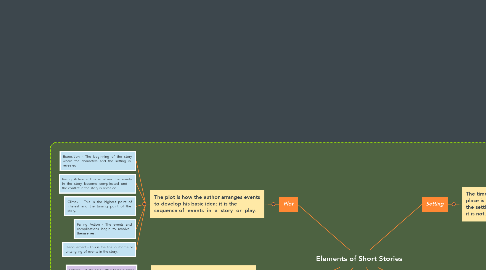
1. Setting
1.1. The time and location in which a story takes place is called the setting. For some stories the setting is very important, while for others it is not.
1.1.1. Place - Where is the action of the story taking place?
1.1.2. Time -When is the story taking place?
1.1.3. Weather Conditions -Is it rainy, sunny, stormy, etc.?
1.1.4. Social Conditions -What is the daily life of the character's like?
1.1.5. Atmosphere -What feeling is created at the beginning of the story?
2. Character
2.1. In order for a story to seem real to the reader its characters must seem real. Characterization is the information the author gives the reader about the characters themselves.
2.1.1. Protagonist – the main character in the story
2.1.2. Antagonist – the character or force in conflict with the main character
2.1.3. Anti-hero - a protagonist with undesirable traits.
2.1.4. Archetype – a character that is familiar throughout all cultures and time periods
3. Plot
3.1. The plot is how the author arranges events to develop his basic idea; it is the sequence of events in a story or play.
3.1.1. Exposition - The beginning of the story where the characters and the setting is revealed.
3.1.2. Rising Action - This is where the events in the story become complicated and the conflict in the story is revealed
3.1.3. Climax - This is the highest point of interest and the turning point of the story.
3.1.4. Falling Action - The events and complications begin to resolve themselves.
3.1.5. Denouement - This is the final outcome or untangling of events in the story.
4. Conflict
4.1. Conflict is essential to plot. Without conflict there is no plot. It is the opposition of forces which ties one incident to another and makes the plot move.
4.1.1. External - A struggle with a force outside one's self.
4.1.2. Internal - A struggle within one's self; a person must make some decision, overcome pain, quiet their temper, resist an urge, etc.
5. Point of View
5.1. Point of view is the position from which the narrator tells the story.
5.1.1. First Person, The personal pronoun “I” and “We” is present.
5.1.2. Second Person, the story is told by using the personal pronoun “you”.
5.1.3. Third Person, The personal pronouns “he/she,” “his/her,” and “they” is present.
